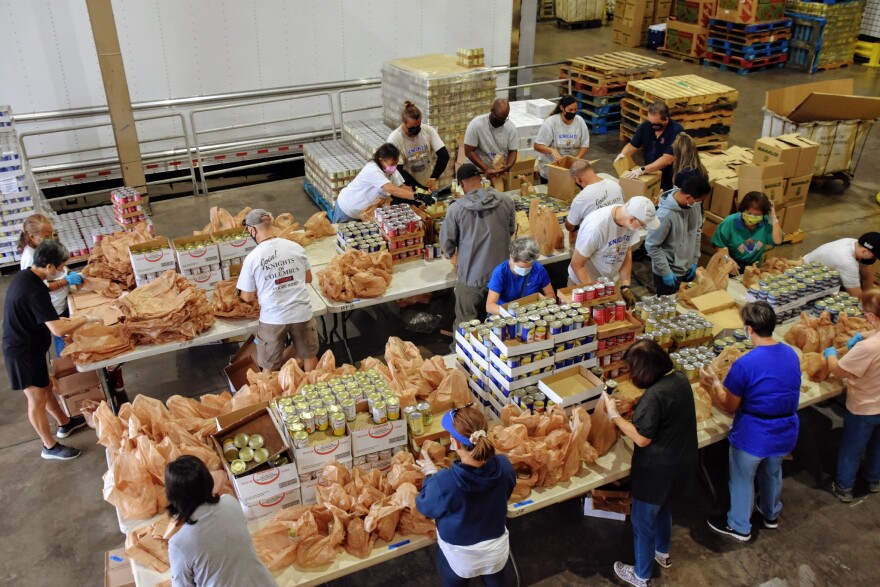The newly signed federal budget bill puts many at risk of losing their monthly assistance from SNAP, the Supplemental Nutrition Assistance Program, formerly known as food stamps.
Over 160,000 Hawaiʻi residents receive these benefits. The new bill adds the monthly 80-hour mandated work, volunteer, or study hour requirement on able-bodied adults up to 64 years old — an increase from the previous 54 years old.
Brandon Taylor, a 43-year-old Nānākuli resident, has been receiving SNAP benefits for his family of six since January. He was diagnosed with a manageable mental disorder, resulting in him being let go from his job.
He scrambled to apply for disability pay, but the process was complex, and the Social Security payment would have taken too long for the immediate assistance he was seeking. He turned to SNAP and the Hawaiʻi Foodbank for help.
“When you’re not getting support and you finally get this SNAP benefit, you feel great that somebody is out there to support you, to help, not judge,” Taylor said. “If SNAP wasn’t there, I'd be homeless or dead. This isn’t some story I’m making up for likes, this is really what happened, and I know I’m not alone.”
Since its inception, SNAP has been fully funded by the federal government through the U.S. Department of Agriculture. But the megabill cuts roughly $186 billion from the program nationally, leaving states to absorb the expenses of the cuts — if they’re able to continue it.
Amy Miller, CEO of the Hawaiʻi Foodbank, said her organization is “already stretched thin” due to the increasing number of people turning to the food bank for support. She stated that Hawaiʻi’s food insecurity rate, 1 in 3 households, will only be made more severe.
“We’re serving as many people right now as we did during the height of the pandemic and about twice as many people as we were serving prior to the pandemic, and that’s before any of these other changes go into place,” Miller said.
She worries that the state’s other food assistance programs won’t have the bandwidth to absorb the thousands of people who will be cut from SNAP.
“Most of the people who are newly seeking food assistance are working families, people who have always been able to make ends meet. They work one or two jobs, sometimes three jobs, and they’ve always been able to do it, and they just can’t do it anymore,” Miller said.

SNAP cuts are not an isolated issue
Nate Hix, director of policy and advocacy at the Hawaiʻi Public Health Institute, explained that it’s important to look at how other cuts within the bill are intertwined. He specifically mentioned the bill’s cuts to Medicaid, stating that food insecurity and access to health care are two sides of the same coin.
He believes that if people don’t have access to affordable and healthy food, their health will decline. But if they don’t have their insurance to be able to regularly see the doctor, their health will take an even harder hit.
“We’re estimating 50,000 people are going to be cut from Medicaid. So for these people who are no longer eligible, that means they’re going to have to go into their pockets for health care,” Hix said.
“That means less money to spend on rent and that means less money to spend on food.”
He added that there are serious ripple effects from these cuts, a big one being centered around school-aged children.
If a parent receives SNAP benefits, their child is automatically eligible for free or reduced-priced meals at school. But if the parent gets kicked off because they’re not eligible anymore, the child also loses access to the discounted rates.
“They’re going to eat less for dinner because the family can’t afford groceries like before, and [the children] are already probably dependent upon free school breakfast and lunch for most of their meals. This would be a double hit to these kids,” Hix said.
But hope isn’t lost
The Hawaiʻi Foodbank receives products in three ways:
- “Retail rescue”: Receiving products that are nearing the end of their shelf life in stores to use at the food bank after being tested for safety and quality.
- USDA commodity foods
- Purchase budget: This is funded by donations and is largely focused on buying local, specifically in the Farm to Families program.
Miller stated the food bank will be focusing on increasing its purchasing budget to supplement the heightened food demand in the coming years. Its purchasing budget is currently about $5 million per year, with about $1 million allotted for fresh produce.
She reassured users and prospective users that the food bank will continue to provide this support for families in need to the best of its ability.
She added that she still has hope, being that Hawaiʻi is so community-oriented and driven.
“My belief is that we will pull together and make sure folks aren’t falling through the cracks, and that isn’t the case in every state,” Miller said. “We are quite concerned about these cuts, of course, but we are still also completely committed to being here for Hawaiʻi's families.”






